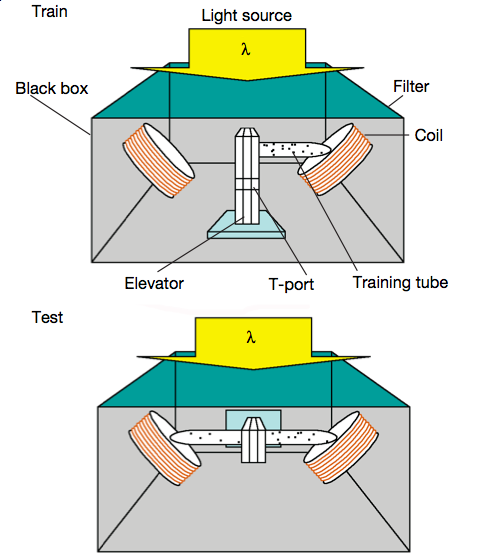Magnetoreception
We hypothesize that migrating monarchs also use a magnetic compass to navigate on cloudy days when neither the sun nor blue sky is visible.
A wide variety of animals are able to detect the Earth’s magnetic field and use it as a source of directional information. In many cases, animal magnetic detection appears to depend on chemical reactions initiated by specific wavelengths of light. The most popular chemical reaction model proposes that light-dependent magnetoreception is mediated by radical pair reactions that are generated in specialized photoreceptors.
Because of their photoreceptor function and biochemical properties, Cryptochromes have been postulated to be the key photoreceptor molecules that generate magnetically sensitive radical-pair products. Recently, we integrated genetic and behavioral approaches to show that light-dependent magnetoreception in Drosophila is mediated by its Cryptochrome (Gegear et al., 2008). We found that two distinct Cry-deficient mutations abolished magnetosensitive behavioral responses, showing that in Drosophila, Cry is necessary for magnetosensitivity. This work established Drosophila as a viable genetic system to delineate the molecular underpinnings of Cry-based magnetoreception in animals.

Gegear et al., Nature 454: 1014-1018 (2008)
Above is a diagram of the setup we used to test for magnetosensitivity in Drosophila. The apparatus is placed inside a black box, and is illuminated from above by a light source modified by wavelength filters. A coil system generates a magnetic field on one side of the box. For training (top), flies are loaded into the training tube with or without sucrose reinforcement and a magnetic field. For testing (bottom), flies are transferred through the elevator to the T-port, where they can choose either tube.
Curiously, a recent paper (Bassetto et al., 2023) suggests that there is no evidence for magnetic field effects on behaviour in Drosophila. Moreover, the authors could not reproduce magnetosensitivity in Drosophila using the binary T-maze apparatus, we developed and shown above. I defend our work showing fruit fly magnetosensitivity and question the conclusions reported in (Bassetto et al., 2023). Further work is needed to refute or verify the proposed lack of magnetoreception in Drosophila (Reppert, Nature in press).
We next used a transgenic approach based on the binary GAL4-UAS system to evaluate the functional roles of the two monarch butterfly Crys in magnetosensitivity. Because monarch butterflies posses both a Drosophila-like Cry and a vertebrate-like Cry, they provide a unique opportunity to directly compare the functional equivalency for magnetosensitivity of each Cry type from the same species in vivo, using transgenesis in Drosophila.
We found that each of the two monarch Crys (Cry1 and Cry2) can rescue magnetosensitivity in Cry-deficient Drosophila and do so in a light-dependent manner (under light shorter than 420 nm). These data indicate that both types of monarch Cry proteins have the molecular capacity to transduce magnetic information (Gegear et al., 2010). The search is now on for a light-sensitive behavioral correlate of magnetosensitivity in migrating monarch butterflies.
Such a behavioral correlate has now been found: Using flight simulator studies, we recently showed that migrants indeed possess an inclination magnetic compass to help direct their flight equatorward in the fall (Guerra et al., 2014). The use of this inclination compass is light-dependent utilizing ultraviolet-A/blue light between 380 and 420 nm. A second independent report that used a distinctive behavioural assay also showed that individual monarchs manifest robust light-dependent inclination magnetic responses to Earth-strength magnetic fields (Wan et al., 2021). Moreover, genetic studies show that the photoreceptive Cry1 protein is essential for the monarch’s light-sensitive magnetic compass (Wan et al., 2021). The recent successful use of reverse genetics in monarchs (Wan et al., 2021) indicates that the butterfly is an excellent choice for delineating the molecular mechanisms underlying light-dependent magnetosensing in the context of compass navigation.